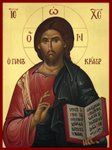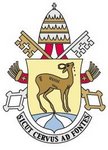Deb, the three youngest kids, and I went to Bratislava, Slovakia on Great and Holy Thursday. We attended, with many from the ITI, the Chrism Divine Liturgy at the Ruthenian Byzantine Cathedral. The cathedral was very small. I am not sure it could hold a hundred people. It seemed to be a converted Latin Rite church.
At the Liturgy itself, the bishop consecrates the Holy Myron (Holy Chrism), consecrates new Antimensia, and washes the feet of priests. 
The Antimension (Church Slavonic: Antimens) is similar to the Western corporal, though it serves a function similar to an altar stone. It is a piece of silk or linen which has an icon of the Deposition from the Cross depicted on it, and relics of a martyr sewn into it. Unlike the Western corporal, the Antimension is not removed from the Holy Table after the Eucharist is over, but is kept in the center of the Holy Table, covered by the Gospel Book. (from Wikipedia)
Here are some pictures of the Liturgy.
Here Bishop Peter Rusnák blesses the congregation with a trikerion in his left hand and a dikerion in the right. He blesses with both hands because he, as a bishop, has the fullness of Holy Orders. The candles represent the Three Persons of the Blessed Trinity and Two Natures of Christ, respectively.
The Bishop is preparing to wash the feet of twelve of his priests. I nearly got the entire iconostasis into the picture. There is one more rank higher than is visible. You can see the large icons of Mary (on the left of the picture) and Jesus (obscured by the cross). You can see three doors. The main door (called the Royal Door; in the center) can only used during particular times in the Liturgy and then only by a bishop, priest, or deacon. The doors (closed) next to the icons of Jesus and Mary are called deacon doors. There are two more icons at that level. The one on the far left (as you look at the picture) is of St. Nicholas. I do not know what the icon is on the far right. The next row up has the Last Supper in the center and the twelve events from Christ’s life on either side. The next row up has Jesus in the center with Mary and John the Baptist (the Forerunner) worshipping Christ. The others are prophets, patriarchs, and apostles.
The bishop washing and kissing the feet of one of his priests.
This is a bishop that was martyred under the communists in the 1970s. I believe his name is Bishop Vasil Hopko.
Here is another martyr-bishop from under the communists. His name is Bishop Paul P, Gojdich, O.S.B.M.
I was not aware that in every communist country, I believe, the Greek Catholic Church was outlawed. Many, many Eastern Catholics were martyred under the brutal conditions of prisons or labor camps.
Holy Martyrs of the Eastern Catholic Church, pray for us!!








2 comments:
Mike, the pictures are amazing!! Thank you so much for answering God's call and allowing us to share your journey with you. :)
Trudy
P.S. Hugs all around (especially Deb) from me!
Fine article and images. I'd like to add only a few words regarding the icons, as I visit the little cathedral quite frequently (for example I was at the long Theophany Vigil services last night). You identified accurately the two Greek Catholic martyr-bishops. The icon on the far right you weren't able to identify is the icon of Exaltation of the Holy Cross, after which the cathedral is named. On the two deacon doors, there are the icons of Melchisedech (left) and St. Stephen Protomartyr (right), respectively. You identified other icons correctly.
Maybe I'd just add that Greek Catholic Church was really outlawed under the communists throughout the Eastern bloc - they wanted its members to become Orthodox, who were viewed as more 'Soviet'.
Post a Comment